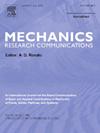基于fft的高角度晶界的偏斜力学及其与原子模拟的比较
IF 2.3
4区 工程技术
Q3 MECHANICS
引用次数: 0
摘要
本文利用快速傅立叶变换(FFT)方法作为连续体缺陷理论在存在界面缺陷,特别是高角晶界(HAGBs)的情况下的应用,解决了确定局部应力场的问题。首先,报告了场位错和斜向力学(FDDM)方程,强调了斜向型缺陷涉及的弹性应变和曲率张量的Stokes-Helmholtz正交分解的使用。然后,按照这种分解,可以解决不兼容字段和兼容字段。其次,采用非均质介质的格林函数法推导了位错和偏斜密度相结合的应力场。采用快速傅里叶变换(FFT)算法,结合一阶和二阶空间导数的有限差分格式(FDDM-FFT),采用谱法对弹性应变兼容张量进行了数值求解。作为该方法的应用,从偏析结构单元模型(DSUM)中得到了两个特定hagb(倾斜轴为[001]的对称倾斜gb)的应力场,精确为Σ29(520)[001]46.40°和Σ149(1070)[001]20.02°。用现有的FDDM-FFT数值方法计算了各向同性和各向异性弹性,并假设了周期性的偏斜密度张量。首先用线性各向同性弹性中偏斜偶极子壁的特定组合得到的解析解对两种HAGBs进行了定量比较。然后,考虑两种不同的FCC金属,即Al和Ag,分析了各向异性弹性对HAGBS的影响。最后,将基于fddm - fft的HAGBs与分子静力学(MS)模拟结果进行了比较,分别采用了维里应力法和基于高斯核的插值方法对Al和Ag的HAGBs进行了模拟。结果表明,尽管FDDM-FFT在描述HAGB缺陷核方面相对简单,但FDDM-FFT结果再现了基于ms的水静力和剪切应力分量结果的主要趋势。本文章由计算机程序翻译,如有差异,请以英文原文为准。
FFT-based disclination mechanics for high angle grain boundaries and comparisons with atomistic simulations
The paper addresses the question of determining local stress fields using the numerically efficient Fast Fourier Transform (FFT) method as an application of the continuum defect theory in the presence of interfacial defects, and specifically High Angle Grain Boundaries (HAGBs). First, the Field Dislocation and Disclination Mechanics (FDDM) equations are reported highlighting the use of the Stokes-Helmholtz orthogonal decomposition for both elastic strain and curvature tensors which are involved for disclination-type defects. Then, following this decomposition, both incompatible and compatible fields can be solved. Second, the Green’s function method for heterogeneous media is used to derive the stress polarization field, which integrates both dislocation and disclination densities. The compatible elastic strain tensor is numerically solved with the spectral method using the FFT (fast Fourier transform) algorithm together with finite difference (FD) schemes for computing first- and second-order spatial derivatives (FDDM-FFT). As applications of the method, the stress fields of two specific HAGBs (symmetric tilt GBs with [001] tilt axis), precisely and are obtained from the Disclination Structural Unit Model (DSUM). They are calculated assuming both isotropic and anisotropic elasticity with the present FDDM-FFT numerical method and assuming periodic disclination density tensors. Quantitative comparisons are first performed for both HAGBs with analytical solutions obtained from specific combinations of disclination dipole walls in linear isotropic elasticity. Then, the effect of anisotropic elasticity is analyzed for both HAGBS considering two different FCC metals, namely Al and Ag. Lastly, some comparisons between the FDDM-FFT-based results with molecular statics (MS) simulations, using the virial stress method and an interpolation method based on Gaussian kernel are reported for both HAGBs applied to Al and Ag. It is shown that, despite their relative simplicity in describing HAGB defect cores, the FDDM-FFT results reproduce the major trends of MS-based results for both hydrostatic and shear stress components.
求助全文
通过发布文献求助,成功后即可免费获取论文全文。
去求助
来源期刊
CiteScore
4.10
自引率
4.20%
发文量
114
审稿时长
9 months
期刊介绍:
Mechanics Research Communications publishes, as rapidly as possible, peer-reviewed manuscripts of high standards but restricted length. It aims to provide:
• a fast means of communication
• an exchange of ideas among workers in mechanics
• an effective method of bringing new results quickly to the public
• an informal vehicle for the discussion
• of ideas that may still be in the formative stages
The field of Mechanics will be understood to encompass the behavior of continua, fluids, solids, particles and their mixtures. Submissions must contain a strong, novel contribution to the field of mechanics, and ideally should be focused on current issues in the field involving theoretical, experimental and/or applied research, preferably within the broad expertise encompassed by the Board of Associate Editors. Deviations from these areas should be discussed in advance with the Editor-in-Chief.

 求助内容:
求助内容: 应助结果提醒方式:
应助结果提醒方式:


